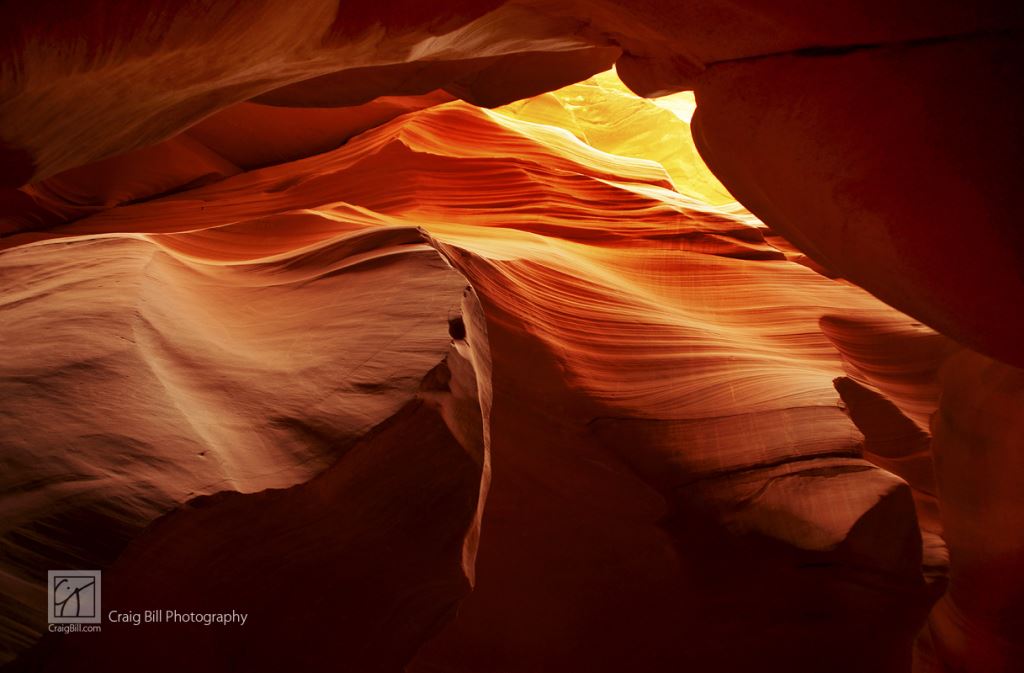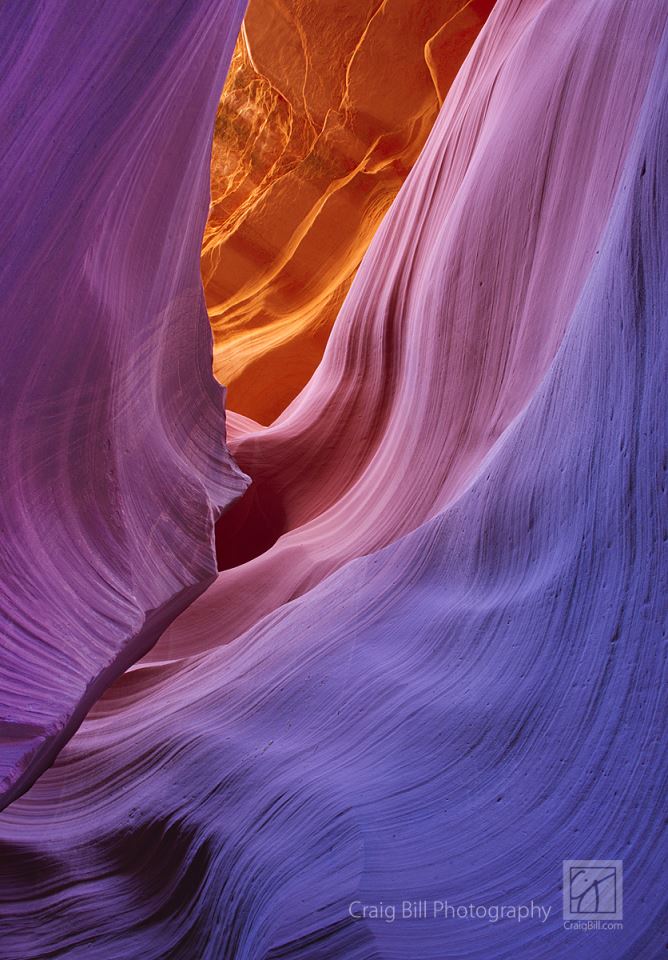Antelope Canyon, an amazing and unusual visual phenomenon that is a photographer's dream and nightmare, is located in the Navajo Tribal Park in Arizona. It thrillingly has two separate sections of slot canyons to experience; the upper being called the “The Crack” and the lower being called “The Corkscrew.” They run about 120 feet deep and are created by rainwater speeding through the basin above the slot canyons, gathering speed as it rushes through the narrow sandstone passageways. Over time this deepens the passages and smooths edges causing the rock to form “flowing” characteristics which create opportunities for great photography.

The Upper Antelope Canyon is the section most visited for two reasons. First, it is the more flat section and requires no climbing. Second, the stunning beams of sunlight radiating into slots from the uppermost openings occur more often in the upper than the lower. Unfortunately, this makes photography within the canyons difficult because of the sunlight reflecting off the walls. The reflecting light requires the broad range exposure often 10 EV or more.
The Lower Antelope Canyon is a few miles from Upper Antelope and is a strenuous hike requiring five flights of stairs of varying widths to get inside and out of the canyon. Visitors should be aware that there are areas without level footing. Also sand consistently falls from above causing the stairs to be slippery.
Some things to know before going to Antelope Canyon. The high season is during the summer months when the sun is at its hottest. The crowds are thick, the wait can be torturous and sunscreen, hats, sunglasses, and bottles of water all must-haves. The guides are all experts on photography using any device and can advise on the best settings for the best pictures. Visitors recommend a setting of ISO 800, on manual and no flash for the best results.
The Sacred Cathedral
Both sections of the Canyon are in the LeChee Chapter of the Navajo nation, meaning that they are accessible only by a guided tour and permit as the Navajo considered them sacred. It was in 1997 that the Navajo tribe made Antelope Canyon into a Navajo Tribal Park and thus restricted its access. For the Navajo, entering the canyon is akin to entering a sacred cathedral. They pause before entering to "become in the moment" or as an indication of respect. They feel this allows the experience to put them in harmony with mother nature and something greater than themselves. Every four years the canyon is blessed, and the Navajo are thankful for its creation by the elements through time.
 Walls of Slot Canyon
Walls of Slot Canyon
Other Cool Spots in Arizona
Arizona is home to several amazing sites, and a great deal of them require some effort to reach yet most say that the effort is 100% worth it. One place that is not too difficult to reach, but worth going to see is the fantastically memorable Grand Canyon. Speaking from experience when one walks up on their first glimpse of this spectacular gorge, it takes the breath away. It is something to be treasured.
One place challenging to reach, but worth it is Beaver Falls in Havasu Creek and Havasu Creek itself, which is a gorgeous blue-green due to the high levels of calcium carbonate.
Hoover Dam is a human-made facility that countless sightseers visit for various reasons such as its size, exciting history, the functions it performs, and it is beautiful in itself.
The Navajo own and control admission to several spectacular landscapes besides Antelope Canyon. There are Hunts Mesa and Monument Valley which you cannot reach without going through the sand dunes. It is a Navajo Tribal Park just Antelope Canyon. There is the town of Sedona, a beautiful place to experience. The town is surrounded by National Forest, which the Native Americans hold sacred, believing the area helps with healing and spiritual renewal. Its streets are lined with art galleries and spas.
 Sedona
Sedona
Finally, there is the 100,000 square mile Sonoran Desert. It is the hottest place in North America, but due to its rainfall, it sustains uniquely beautiful plant life.
A Photographer's Dream and Nightmare
Antelope Canyon in Page, Arizona is a photographer's dream and nightmare. There are rules to what can be carried in and photos without people can be challenging to accomplish. Tripods and specific other photographic equipment are not allowed at times, so steady hands are needed. Backpacks are not permitted because the passages are extremely narrow in some spots. The most expensive photo in the world was taken in Upper Antelope Canyon. The canyon is most famous for the visual phenomenon of beams of sunlight shining down through the holes or slots.

If Push Comes to Shove
If one must choose only one canyon to tour, which should it be? The upper canyon is internationally famous and therefore more crowded. However, the upper canyon is also the easiest to enter and leave. It costs more, and it can be very crowded, but there are more beams of sunlight shining through the upper. Getting a photo without people in it is difficult at times. The lower canyon is less crowded and cost less but is more difficult to reach and leave. Both canyons are unique, but it is a lot a lot of money to see both. Besides the entry fee, there is a small Navajo fee. However, visitors never mention the price they paid to tour the Canyons and behold these beautiful national treasures.